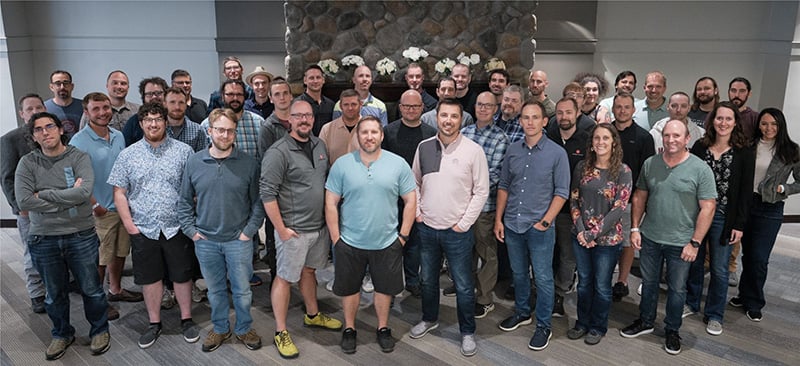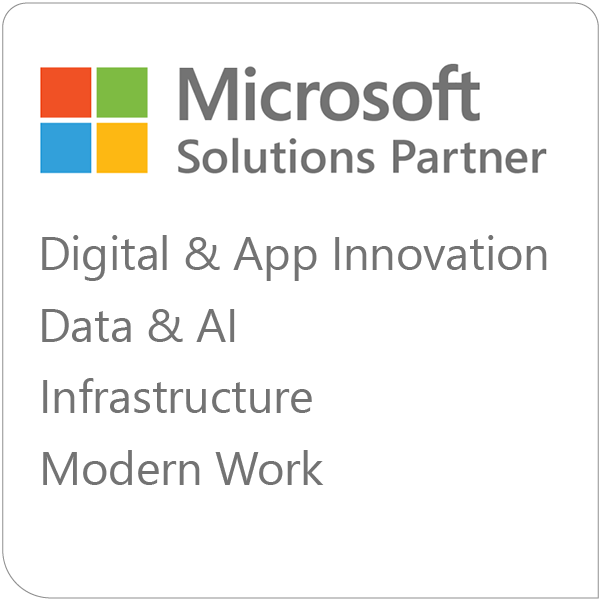In This Blog:
- What is Microsoft Fabric?
- What Can Microsoft Fabric Do?
- How is Microsoft Fabric Consumed and Priced?
- Compute, Storage, and Technical Specifications
- Understanding Smoothing and Throttling
- How Can Microsoft Fabric Benefit My Business?
- Getting Started with Microsoft Fabric
- Frequently Asked Questions
Chances are that your organization is powered by data. In 2025, many companies rely on their data assets as an integral component to business success and longevity. Therefore, having robust, scalable solutions for managing and analyzing their data assets is imperative.
Microsoft Fabric emerges as a groundbreaking solution that transforms how enterprises handle their data analytics needs. This comprehensive guide explores Microsoft Fabric's capabilities, pricing structure, and business benefits.Microsoft Fabric represents the next evolution in cloud-based data analytics platforms, unifying multiple Microsoft Azure data services under a single, cohesive umbrella. This innovative platform seamlessly integrates essential data tools and services, including Data Factory pipelines for data integration, Synapse Analytics for comprehensive data engineering, warehousing, and data science capabilities, and Power BI for advanced business intelligence and reporting.
Built on modern data lake and data warehouse concepts, Fabric creates a unified environment where data professionals can collaborate effectively on complex data projects.

Microsoft Fabric provides a unified interface – a "single pane of glass" – where organizations can manage their entire data lifecycle. Within this environment, teams can build sophisticated data pipelines ranging from simple transformations to complex data engineering workflows. The platform enables users to create comprehensive reports and visualizations for data analysis and business intelligence needs.
The platform supports various development approaches, from low-code solutions for basic data transformations to advanced Spark Notebooks utilizing SparkSQL, PySpark, and more for detailed pipeline creation. This flexibility ensures that both citizen developers and experienced data engineers can work effectively within the same environment.You may also like: What is Github Copilot
Microsoft Fabric adopts a flexible consumption model with two primary pricing options: pay-as-you-go and reserved capacity. The platform operates on a "Unified Capacity" model, simplifying resource allocation and billing across all Fabric operations. To help organizations make informed decisions, Microsoft provides detailed comparison charts between Fabric and Synapse capabilities.
Compute Resources
The entry-level F2 SKU comes with 2 capacity units. Customers can choose between:
-
Pay-as-you-go pricing: $0.36 per hour, which equates to approximately $262.80 per month.
-
Reserved capacity pricing: $0.215 per hour, or approximately $156.33 per month when reserved in advance.
These rates are subject to regional variations, and customers should consult Microsoft's documentation for specific pricing in their location.
Storage Architecture
Fabric leverages OneLake storage, implementing a "single source of truth" approach where all data is stored in a single, centralized location. The storage pricing structure begins at $0.023 per GB per month. Organizations have the flexibility to add disaster recovery (DR) options based on their business continuity requirements.
Note: The Unified Capacity model implementation is currently in progress, with ongoing enhancements being developed.Organizations should be aware that OneLake cached data will incur additional charges beyond the base storage costs. Fabric includes free data mirroring capabilities, with limits determined by SKU tier. For F2 SKUs, the free data mirroring limit is set at 2 TB, while higher SKU tiers offer increased mirroring limits.
Microsoft Fabric implements sophisticated resource management through smoothing and throttling mechanisms. Smoothing optimizes compute usage by distributing workload evaluation during spike periods, leveraging unused idle capacity. This process operates over a minimum of 5 minutes for on-demand runs and extends to 24 hours for scheduled and background jobs.
Throttling activates when capacity usage exceeds purchased CPU resources, even after smoothing is applied. This can impact process performance and user experience, potentially leading to delayed or rejected job execution in extreme cases. Organizations can implement proactive monitoring by setting up alerts before throttling occurs, enabling more flexible workload management.Understanding Smoothing
Smoothing functions as a key optimization system that helps reduce compute usage over time in Microsoft Fabric. When sudden spikes in workload occur, the system intelligently spreads out the evaluation of compute tasks by utilizing any available unused idle capacity. A crucial advantage of this mechanism is that it accomplishes this resource distribution without affecting the overall execution time of your workloads.
The smoothing process operates on two distinct timescales depending on the type of workload. For immediate, on-demand runs, the system distributes the workload over a minimum period of 5 minutes. For scheduled operations and background jobs, this distribution can extend across a full 24-hour period, enabling more efficient resource utilization during off-peak hours.
Understanding Throttling
Throttling is activated when your capacity consumption surpasses the purchased CPU resource limits, occurring even after smoothing has been applied. This protective mechanism can impact system performance in several ways: processes may experience slower speeds, which directly affects end-user experiences through increased response times. In more extreme cases, throttling may cause jobs to be delayed or even rejected from execution entirely. Importantly, throttling only applies to new workload submissions and does not affect any processes that are already running, ensuring the integrity of in-progress work.Optimization Benefits
Understanding how smoothing and throttling work together is essential for right-sizing your environment effectively. Microsoft Fabric provides the capability to set up proactive alerts that notify administrators before throttling conditions occur, allowing for preventive measures to be taken. This comprehensive approach enables a more flexible workload environment, helping organizations optimize their resource utilization while maintaining consistent performance standards.
Learn More:
For in-depth technical details about implementation, configuration, and best practices regarding smoothing and throttling mechanisms in Microsoft Fabric, please refer to "Smoothing and throttling in Fabric Data Warehouse" in the Microsoft Fabric documentation.
Microsoft Fabric transforms business operations through its innovative approach to enterprise data management. At its core, the platform offers centralized data management, eliminating the traditional challenges of dispersed data sources across multiple systems. This centralization ensures that all teams work from a single, authoritative data source, reducing errors and improving decision-making accuracy.
A significant advantage of Fabric lies in its ability to reduce context switching. Teams no longer need to juggle multiple tools and platforms, as all necessary functionality is integrated into a single environment. This streamlined approach significantly improves productivity by allowing data professionals to maintain their focus without constantly transitioning between different interfaces and tools.
Collaboration becomes seamless with Fabric's unified approach to data projects. Teams can work together efficiently, whether they're data engineers building pipelines, analysts creating reports, or data scientists developing models. The platform's architecture supports real-time collaboration while maintaining data consistency and version control.
One of Fabric's key strengths is its leveraging of familiar Microsoft tools. Users already experienced with Power BI, Synapse, Data Factory, or SQL will find themselves working with familiar interfaces and workflows. This familiarity significantly reduces the learning curve and accelerates adoption across organizations.
The platform's single-copy approach to source data represents a fundamental shift in data management. By maintaining one authoritative copy of data for all operations, organizations can ensure consistency across all analyses and reports while reducing storage costs and simplifying data governance.
Being cloud-based, Fabric offers the inherent advantages of cloud computing: scalability, accessibility, and reduced infrastructure maintenance. Teams can access their data and tools from anywhere, scale resources as needed, and focus on delivering value rather than managing infrastructure.
Getting Started with Microsoft Fabric
Organizations interested in exploring Microsoft Fabric can take advantage of a 60-day free trial period. Additional learning resources include the Guy in a Cube channel on YouTube and the official Microsoft Fabric Blog, which provide detailed tutorials, best practices, and implementation guidance.
Through its comprehensive capabilities, flexible pricing, and robust technical features, Microsoft Fabric represents a significant advancement in enterprise data analytics platforms. As organizations continue to navigate the complexities of modern data management, Fabric provides a unified, scalable solution that can grow and adapt to meet evolving business needs.
Contact us today to discover how our services can help your business succeed. Our expert team provides tailored solutions to optimize your technology infrastructure, enhance productivity, and drive growth.
Frequently Asked Questions
What is Microsoft Fabric?
Microsoft Fabric is a comprehensive cloud-based data analytics platform that unifies various Microsoft data services—including Power BI, Synapse, and Data Factory—into a single, integrated environment. It provides a consistent experience for data professionals, analysts, and business users alike, making it easier to manage, analyze, and visualize data at scale.
What can Microsoft Fabric do?
It enables end-to-end data workflows, from ingestion and transformation to modeling and visualization, all within a single interface. Fabric supports both code-first and low-code approaches, enhanced by AI-powered capabilities through Copilot, allowing teams to work more efficiently and reduce manual effort.
Fabric uses a capacity-based pricing model with flexible options, including pay-as-you-go or discounted reserved capacity. Pricing starts at the F2 SKU ($0.36/hour PAYG), and for capacities below F64, an active Power BI license is also required to access full functionality, especially for Pro and Premium users.
How can Microsoft Fabric benefit my business?
It streamlines data operations by centralizing storage, processing, and analytics within a single platform, reducing the need for multiple disconnected tools. By enabling smoother collaboration and minimizing context switching, it helps teams deliver insights faster and more consistently across departments.







